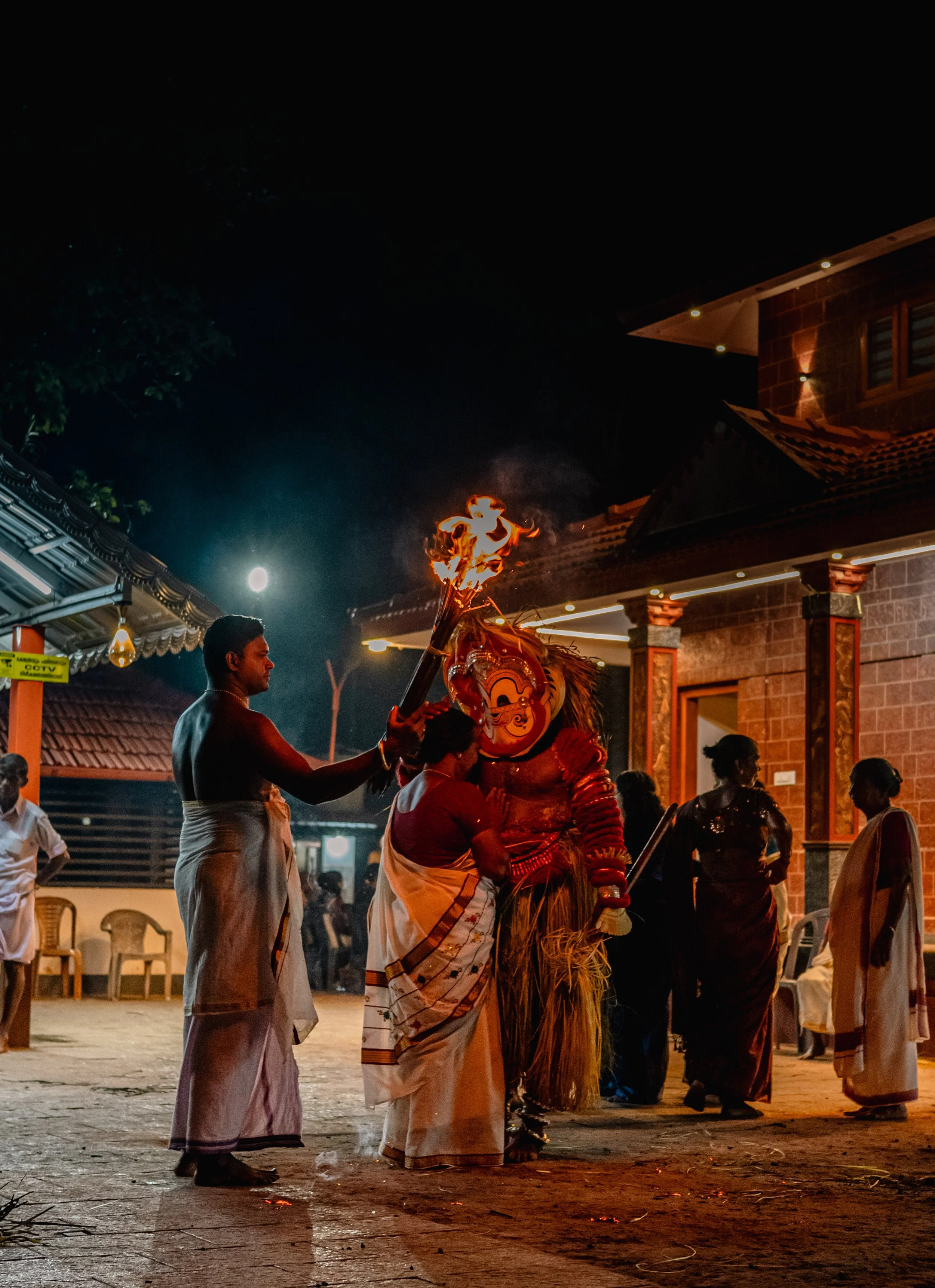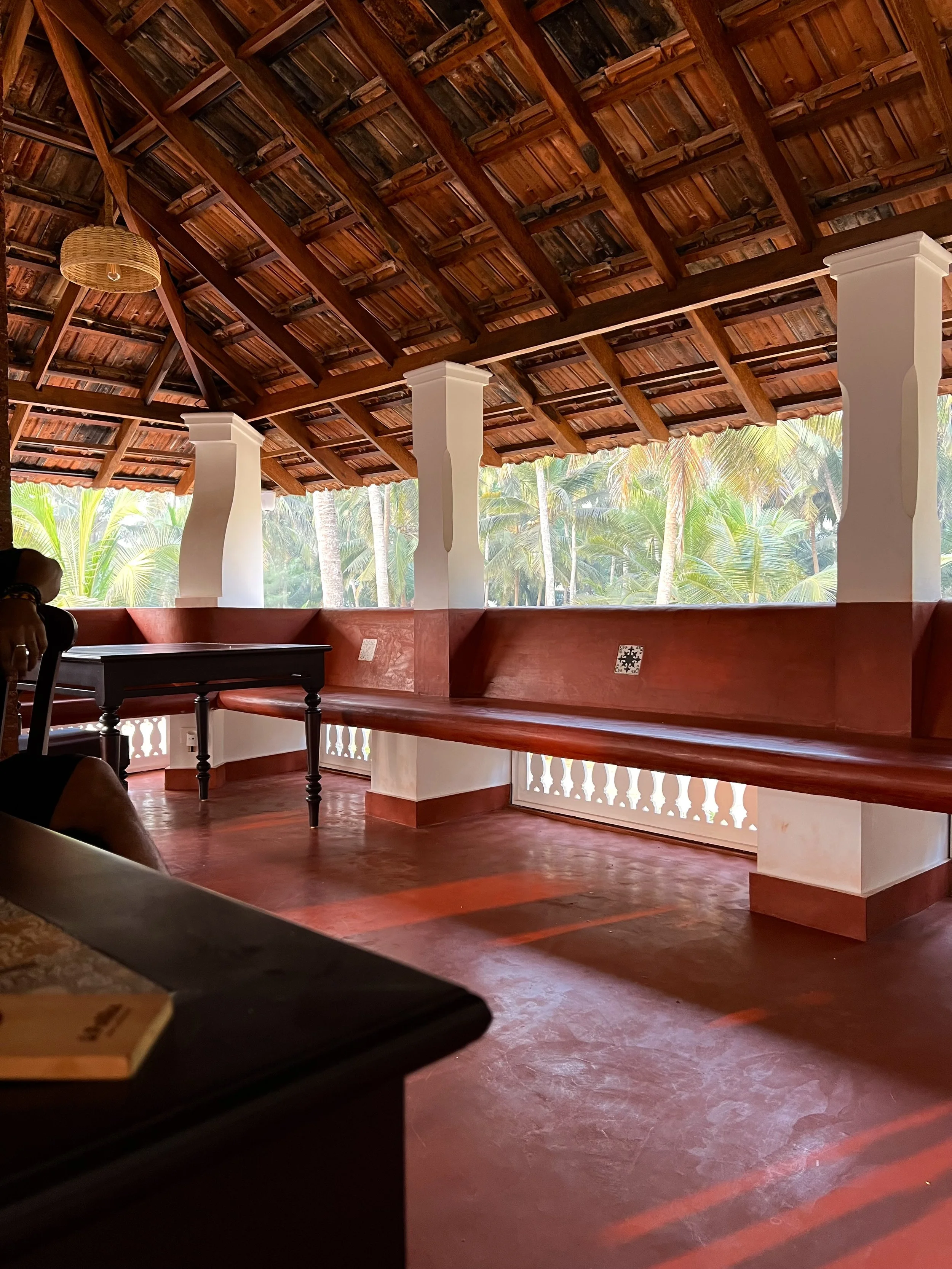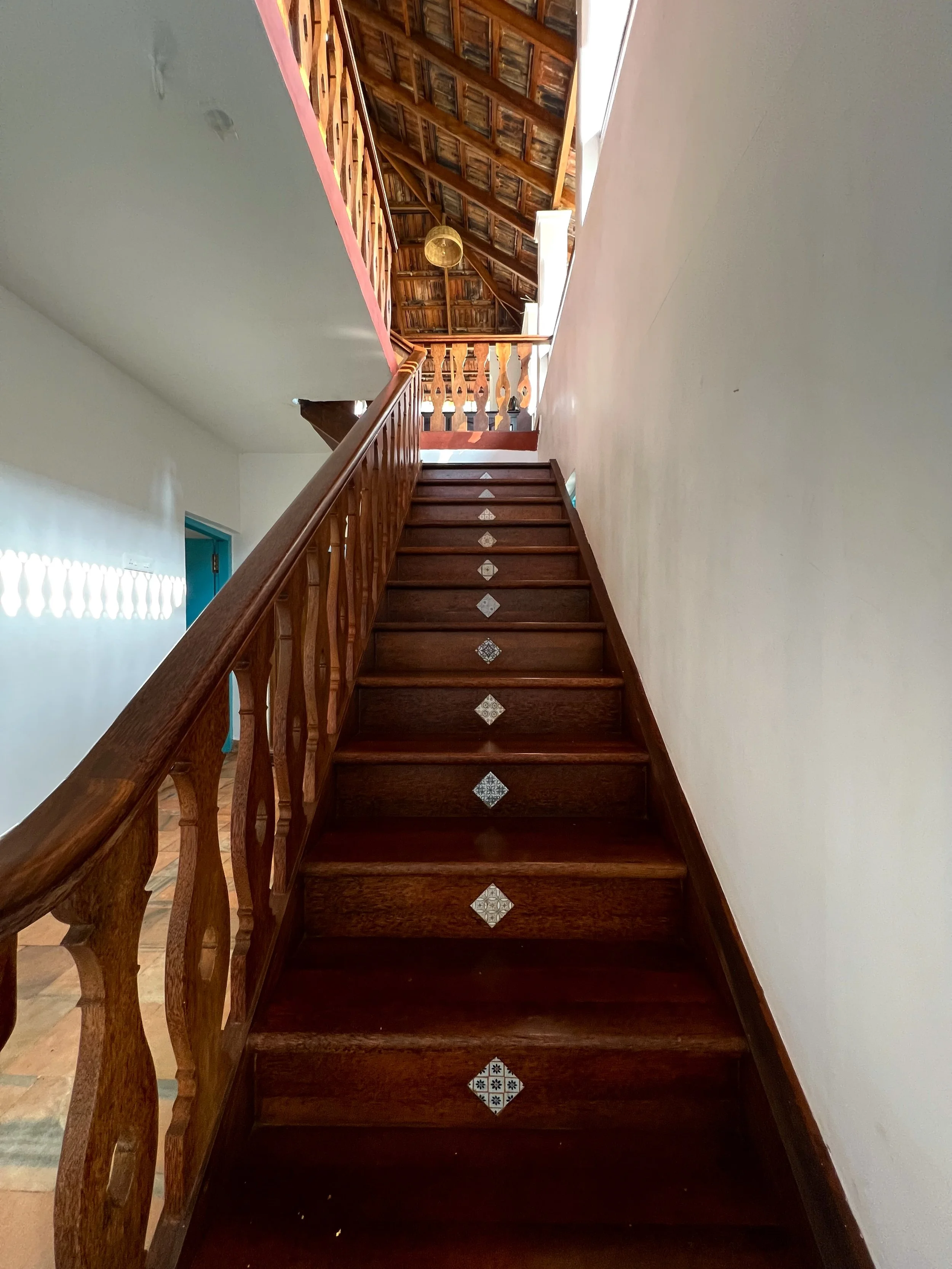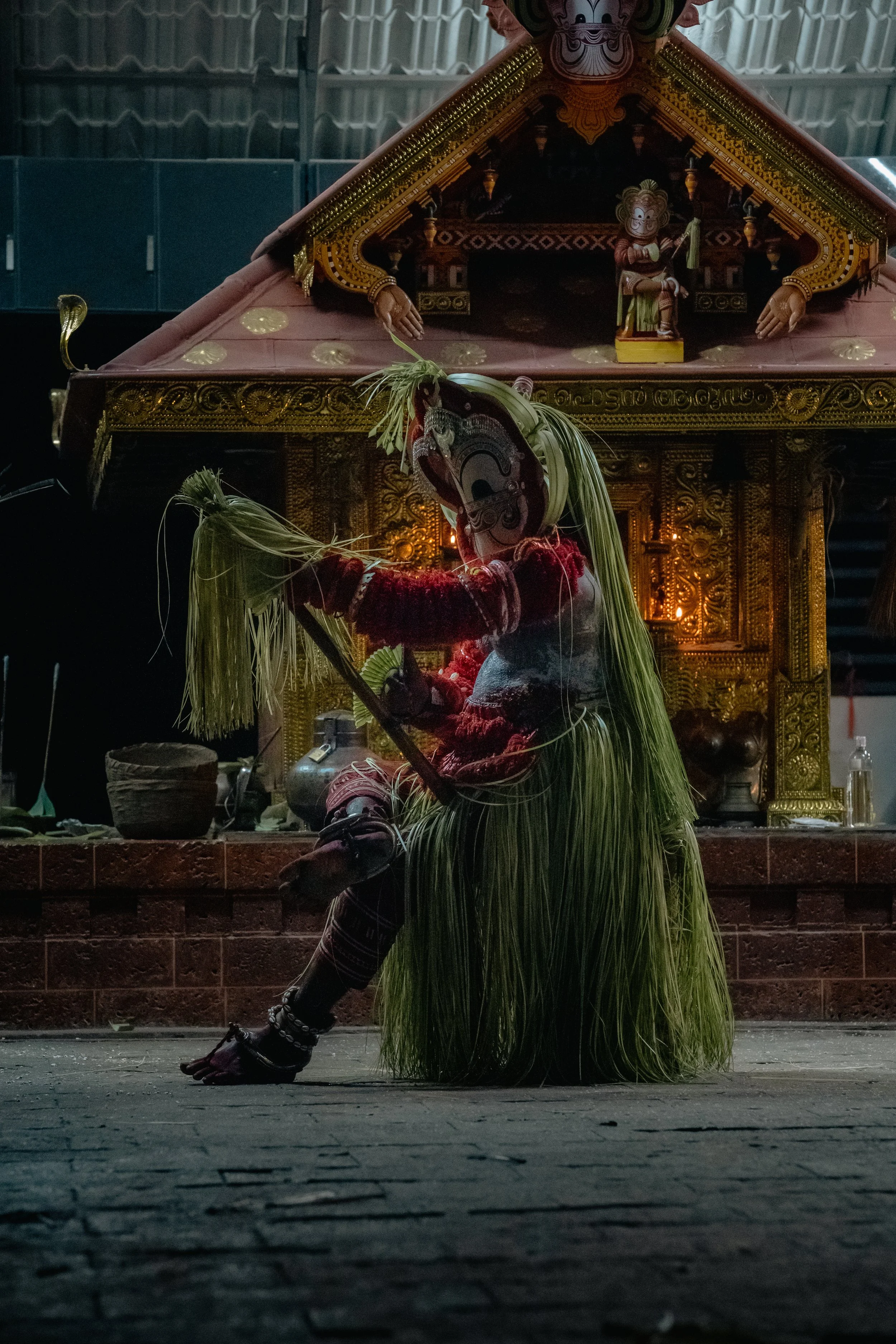Finding God in Kasargod Part 1
I’ve been dreaming of witnessing theyyam since forever. And every year, despite an almost 6 month season, we never made the time to drive down and access this immensely life-changing experience that our home state has to offer. For that’s what theyyam is - life changing. It can possess and mystify you in ways that you wouldn’t have thought possible. Even if you happen to be a rather hardened atheist.
So what changed this year? Our friend Krish happened. All I did was share a Kandanarkelan reel with him and our man was talking dates, laying down plans, marking it on his calendar. That’s Krish for you - no castles in the air, no hmming or hawing - just set-in-stone plans, thank you very much. We all need a Krish in our lives. Before we knew it, we were making phone calls enquiring about stays and how to put an itinerary together. We were leaving in two weeks.
Theyyam is a ritualistic practice and is predominantly performed in ancestral homesteads or tharavadus. As outsiders, we were a bit out of our depth about some basic ground how-tos - how does one go on about getting an invitation to randomly walk into someone’s courtyard? How do we know the location? How to find out the schedules? Turns out Theyyam is hugely popular and there are countless Theyyam tours that put together itineraries and travel packages - especially in Kannur. At a short sighted, first glance, it might so appear that Kannur is THE destination for Theyyam. And it so happened that I had seen a reel featuring a gorgeous property in Thalassery a while ago and had saved it my places to visit. How propitious!
I messaged Polika - the brand that runs the aforementioned gorgeous property - on Instagram and they got back after a while but it was all too vague. Meanwhile our friend Sapna - the other half that completes “more action, less flakey dreaming” Krish - called the number on the account and spoke to a certain person called Manoj from Polika and got some hard answers. And a whole lot of insider information.
Why am I telling you this? For the three of four people who read my blogs for travel advice this is solid gold. Doing our Theyyam travels with Polika might have been a bit on the pricier side but it was so worth it. Theyyam tours are a dime a dozen and many of them are exactly that in dimes and dozens. It can get crowded, the stays can be a bit “not right for this side of 40” and you’ll be getting one hell of a buzzkill, trying to keep up with someone else’s pace, someone else’s taste and someone else’s decisions. At this age I’m not looking for bucket-list currency, I’m looking for meaningful experiences. Connecting with the history of the place (if I can afford it), getting closer to the culture of the place (again, if I can afford it) and taking my own time - these are super important to me as a traveller. Yes, I know - I should have been born with generational wealth but I don’t and so here we are - making the best of the situation.
Back to Manoj from Polika. For starters, Manoj, who is now Manoj chettan (big brother) to us, advised us to consider Kasaragod instead of Kannur as a base as this would give us access to much smaller, more authentic and intimate rituals. I shy from using the word performance, even though there is a severe want for a better word - because it much beyond a performance. It’s sacred, it holds together the history of the host, it transcendental - in a truer way than any art critic has ever used the word - and so ancient that even a camera-wielding witness (me) snapping pictures as if their life depended on it, manages to encounter the divine.
I’m not giving Manoj chettan and his hospitable ways much of a chance, am I? To put it shortly - he gave us two choices of Polika properties - Heritage 1866 in Thalaserry or Aavi Beach Retreat at Kasaragod. And he recommended the latter, even though it’s a much smaller property. Albeit a smaller property that sits right on the beach. After some amount of hemming and hawing, we decided to listen to him - thankfully.
While Kannur undoubtedly is the capital of Theyyam - a title conferred by tourist numbers than anything else, in my definitely-could-be-wrong observation, other Malabar districts like Kozhikode and Kasaragod give you the equivalent of front row seats, intimate experiences and authenticity.
Aavi Beach Retreat is located in Nileshwaram and if you’re travelling from Bangalore, Google Maps might take you through some seriously dubious but no less stunning routes. When the Malabar hillscape is not covered in monsoon greens, it turns fiery, like some sleeping demon, all red sand and scorched grass. About 50 km from the property, we found ourselves cutting through one such “path” - calling it a road would have been a really generous stretch - that after worrying us for a good fifteen minutes connected us back to the highway. At the fag end of February, Kasaragod’s undulating pre-summer scapes turned into burnished gold in the afternoon, made me want to jump out of the car and begin photographing. But we were tired after a long, circuitous drive and we just wanted to get there. Every part of our body was screeching “Are we there yet?” But even now, the bleak beauty of that field, like a hymn sung to some bloodthirsty god, haunts me.
These are portents - that tell me that I will be back again. When a land sends me unrequited heart-furls that stay alive, like “almost a memory” postcards. Sometimes, I feel them even more strongly than the things I actually got to experience.
We reached Aavi as the day began preparing a “sulaimani” sunset. Sunsets by the Arabian Sea look like they were brewed and distilled with the finest of tea leaves. All gold and fire. And the open dining area of Aavi is one gorgeous place to soak in a pretty sunset. Or a pretty morning. Or a pretty any time of day. The view is straight out of tropical dream - a dancing curtain of coconut fronds distils the view of a bright, roaring sea with softening leaf light and shadow - so that you can stare into your pleasantly light-controlled horizon. The dining space, with its amber red oxide flooring that rise to become bay seating, the coconut wood and laterite bricks pillars give you a much-needed sense of grounding after being on the move for so long. We were welcomed by Sanish with promises of tea and pazhampori (banana fritters) after we had freshened up a little.
To be fair, the rooms are a bit small. They are edifices that in no uncertain, minced-words terms, establish that you have to be some kind of loser to be spending time inside, when you have an entire beach to yourself. Inside, you find traces of the care they’ve put into curating the Polika experience. Locally made sheets sourced from the local handlooms, towels that aren’t “template Turkish” but a fabric that is nothing less than a vessel of political history, wood work crafted from the coconut grove outside - make you feel that much more connected with the land. A little verandah reminiscent of old homesteads, hugs each room. Just the kind of place for losing track of time with a glass of tea (kattanchaya, of course) for company.
Out here, it’s easy to paint a picture of evening bliss. The cool of the red oxide regulates your temperature while hot tea fills your soul with the equal of the soul of an oversimplified motivation poster. Not your reaction to it, but its smug, zero self-aware, blissful soul. Truth be told, you couldn’t give two sh*ts about anything else other than this moment of meditative quiet.
Kerala is passionately a tea-drinking state. Tea, with or without milk are two different emotions. As someone who simply cannot drink milk tea, this would be a rather secondhand report. But I’m willing to wager that the humble “paalchaya” is the average Malayalee’s safe space. Morning jump-start? Paalchaya. Break between work? Paalchaya. Life getting a little hard to bear? “Paalchaya”. Hanging out with the “bros”? “Paalchaya”. Got a political revolution to execute? But first, Paalchaya. The chayakada or tea shop, depending on where you are, is/was the very crux of Kerala’s social structure. A veritable petridish of that particular locality - it’s the place where menfolk congregate, discuss current affairs and market prices (purely on a local level) share market findings and the inner-workings of the humdrum, and of course, gossip. The local chayakada is living proof that men gossip. And they gossip hard. Verbal tea is always on the menu. The chayakada has been a hyperlocal newsdesk before hyperlocal or news desks were a thing. It is the heart of the community and tea runs in its veins.
Then there is team kattanchaya. If paalchaya is an emotion, kattanchaya or black tea, is panacea. It’s for life’s harder moments. There is a gravitas to that tumbler or cup that you hold in your hand. Restorative forces are deep at work with every sip. It’s a four o clock drink, accompanied with deep fried snacks and the relief of mentally checking out for the day. It’s the heroic hug in a mug or glass that tries to fix you. It’s the phew that punctuates the very human condition. Whatever that means. I’m a kattanchaya person through and through.
Manoj chettan had promised that, the storyteller from Theyyam Trails would stop by as soon as we reached so as to chart an itinerary. Sangeeth joined us as we were having our tea and talked to us at length. This is the process - the storyteller meets you well before chalking out your itinerary. I’m guessing he got a very enthu-cutlet vibe from us - for he asked us if we were up to seeing a theyyam that very evening, though original plans were to begin first thing next morning. Catch three performances during the day and then set off for the famous Kandanarkelan Performance in Kannur which was about 50 km away in the dead of the night. Of course we said that we were up for adding one more theyyam experience. A long dreamt dream was taking the shape of reality sooner than expected and I was excited. I honestly believed that some part of my destiny was linked to the realisation of this dream. That upon witnessing and being a part of this ritual as a spectator, I would open some door or connecting passage to my destiny. And right now, I was almost turning the doorknob.
When I think back to this quick getaway, I can’t help but wonder if time is a lot more elastic at Aavi. We were there for less than forty eight hours but did so much. It felt like we had endless golden hours and sunsets that melted slow and sweet that went on forever. I remember spending what felt like a lot of time on the beach when it was barely more than a couple of hours. I think time does get more languid on a beach that’s almost private. A quiet, clean, empty beach is not something to be taken lightly. It is magic. At a distance you see a clutch of villagers sitting on the beach sand under the watchful eye of a communist flag that flutters proud and strong in the wind. A mysterious square structure, barely hip height sits with a net covering. Curious Krish of course had to get to bottom of it - and get to it he did. He came back and reported that this beach has been welcoming a certain guest for over 100 million years - the Olive Ridley turtle. And in the recent years, the villagers have taken it upon themselves to protect the eggs until they’re hatched - and therefore, the mini, makeshift turtle NICU. The journey of the hatchlings to the sea is a sort of event, with many an eye glistening like proud parents sending their children out into the world.
Dinner was a desperate prayer for more stomach space. Malabar hospitality is a fine art and our dinner was proof of that. The spread included neypathal - a sort of fried rice-flour bread (more like bread from heaven), chicken curry, kappa (tapioca), squid, fishfry, chammanthi aaaaand since I specially requested - mussels. Even though I grew up on the Arabian Sea coast, mussels were not a thing that existed in my universe until my Kannur friend brought some just for me. Arrgh my world imploded - I mean how unfair, we literally share the same coastline and only they got to stroll over to the local market and come back with mussels. The north districts of Kerala - Kannur, Kozhikode and Kasaragod must love this little exclusive gift from the sea. They’ve found ways to include as much of this seasonal goody as they can, right from tea time snacks to devilishly scrumptious “curries” that make you eat way more rice that you thought you were capable of eating. And this is where we found ourselves at dinner. Tucking away like there was no tomorrow, or more like, there was a tomorrow without mussels or fish fry or varuthuaracha chicken curry or tapioca or neypathals. Which was technically true because we would leave and Bangalore does not particularly abound in these dishes. The chef Anish came up to say hi - a very shy person who nearly died blushing at our effusive “compliments to the chef”.
We had resolved not to eat too much because we were supposed to leave for the Theyyam venue in a bit. But at that kind of a spread, even the hardest resolves would buckle its knees in submission. We found comfort in the fact that all the exertions of our excursion would be a great way to digest (and burn all this wanton calorie collecting). Such are the ways the middle-aged brain works. And tricks.
Sangeeth came by just as we were got done with dinner. And we set off. It wasn’t very far from where we were staying and was taking place in a family-temple. Something about that drive made me feel like I was a child again, back in the weak halogen-lit nights of the eighties and nineties, where an almost predatory pitch darkness preyed just outside the protective white cone of light spilling from the street lamp.
In this dark, we stumbled down a very steep road, almost impossibly steep that vehicles would really needed to fight the natural forces of gravity - to the hallowed, lit grounds of the family temple. Made me think how this little oasis of light must have signalled to the night traveller, lost and disoriented in the pitch dark, back when street lights and electricity weren’t quite so ubiquitous. Back when the pitch dark held many terrors.
There is a sort of gradual build up to the moment when man becomes god right in front of your eyes. While you take in your surroundings you see bored children, a pile of glowing live embers, elders talking in hushed tones, and a clutch of chenda musicians talking to each other quite casually. A priest goes on about performing his duties to a deity in front of a small shrine. On the same grounds there’s a bigger building - like a two-roomed single storied house - the actual sanctum sanctorum housing, in the place of deities, weapons. A single beat gets its hooks into the night. A couple more, like testing waters, follow. A a few more slowly gathering rhythm and power. And fervour. Slowly becoming a narrative, a curtain that slowly unfurls, dark clouds rolling away to reveal the moon. You hear him before you see him. A clanging of anklets that will haunt you for a lifetime. An echo that will bring you back to this moment, when you didn’t know yet, just how life changing, just how significant it is going to be.
The word Theyyam comes from Dhaivam. A sacred act of defiance by downtrodden castes, which has their so-called upper caste masters stand in reverence with folded hands. Theyyam artists or the Koladhari are always from lower social castes, and become a conduit for a divine conscience, that’s missing way too often. The voice of the oppressed while the very system that otherwise denies them equal footing, pays obeisance with folded hands. They laugh at a society that allows for humans to be segregated and classified by the circumstances of their birth rather than their merits. A system that watches impassively at selective injustice, so much so that the people of a lesser god need to become god itself.
While all these thoughts of how these mystic rituals must have evolved over than 2000 years ago, how this indomitable hacking of the system must have come to be, that clang of heavy anklets, that echo of chenda cleaves open the silence of the night, to burst into an aural equivalent of fireworks. And then an excessive god, a god that defies the very idea of god, A god that takes up space, literally and metaphorically, with his red fur arms, massive clanking anklets, and a costume that tells a million defiant stories. A god with a self-deprecatory name like Pottan that actually means fool. But shows how foolish everyone and everything is. A god who isn’t self-involved but challenges you, looks you in the eye and turns your stomach to water.
It’s an uncanny thing. To look god in the eye. That spiritual whiplash of being allowed behind the curtains, to see a rather diminutive man slowly embodying the divine rage. To occupy that hair’s breadth between fact and the undefined. To allow mysticism some room in my doomscroll-addled brain. A god impervious to the prejudice and oppression that gave birth to his legend. A god at once dispassionate and compassionate. A man transcending all that makes him human. A god that finds expression in the most human thing to do. Dance.
A priest who until so far was going on about preparing for the ritual in a very priestly way, starts to twitch. Almost like a possession. You feel you’re on shaky ground - there is a distinct shift of energy. The twitching priest is no longer twitching, he’s flailing. Unnerving doesn’t begin to describe the riot of gooseflesh, skin crawl, heart aflame, hair on edge sensations you go through as you witness a human turning into a god. Like a growing storm, the smoke gets thicker, the movements get more frenzied and the chenda grows into a chorus of heart flutters, echoes and pure feeling. Pottan takes over. And for the next forty five minutes, there is a sarcastic god in a tutu made of tender coconut fronds and an almost comical mask, ridiculing society with furious song, dance and an absolute disregard for the laws of human skin and fire. Embers fly and mayhem rules. The priest and Pottan get into a full blown tussle. - there is something so occult about it, you wonder if it will wake things that are better off asleep. In my mind, a tempest of thoughts. Of how homogeneity comes in, like a disease, trying to erase the distinct voices of a land. The smaller gods, the more ancient ones, the ones that occupy a more obscure pantheon. Names our forefathers knew, but now are strangers to us. Destroying a god is a might damned thing. These songs need to be sung, lest they be forgotten.
To call this a performance, to measure it according to the “tricks” or any one particular element of this experience is reductive. How are you supposed to put into words what it’s like when a god looks you in the eye. When he sits, all casual, on glowing embers, making social commentary in all levity, like he was lying on a deck chair. Howling with laughter, remarking on how chilly it is, while red hot sparks scatter around him. Some of them fly your way and it’s in your interest to dodge them - you might not find it so chilly. The fact that he is still in fact human flesh and bone, hits you when the other people involved in the ceremony physically removes him from the fire. Only for him to run back and lie almost barebacked, on the coals. God in soul but human in body - that’s one way to get hurt - not unlike the hangover after an all night bender. I couldn’t help but wonder if he was going to wake up with nasty burns the next morning.
At the end of the ritual, we all gathered around Pottan for his blessings. He looked at my beaming face and asked me “Happy that you got to see Pottan?” My fulfilled heart runneth over as I nodded all enthusiastic and ecstatic. He blessed us all with good fortune, health and success in everything we did. We were happy. It’s known that sometimes people receive prophesies or get chastised for very specific reasons. So as generic as our blessing was, none of us would complain at its fruition. That night, slightly altered versions of ourselves went to bed.




































